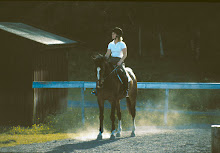Peek-a-booo
Travelling is nice, but I believe it is time to get back to horse once again.
One of the things Fame and I have been working hard on to get in place during the winter was the counter canter, to enable us to step up a class in the shows when spring came.
I thought I would post on that.
Both what we have been doing, and some general info.
First some general info:
Counter canter is a useful exercise to straighten the horse and to improve balance and strength in the canter work, and to make the horse obedient to the aids. It is also one of the steps towards simple changes.
Normally you start the work with counter canter when the horse has achieved a good balance in the normal canter, and where he can keep balance and rythm when doing changes in stride length.
So what did we do?
First steps:
We started the early work with making a single serpentine in "normal" canter, a soft turn off the track from the long side into the second track (inside and parallell to the track along the arena) and back again while trying to keep the balance and the rythm. While riding the serpentine the horse is working in counter canter even if it is a small, soft and long turn.
I focused on keeping my weight to the inside (canter side), and to support Fame with my outside leg and make the turn soft and smooth.
When this was working OK, we proceeded to the next step which was to give the aids for counter canter from walk (or trot) on the long side, along the track.
Sometimes the horse has problems to take the counter canter lead in the beginning.
Not surprising as most of us have trained hard to get the right canter lead before this stage!
This might be caused by the position of the rider, or that the horse needs a bit more room on the canter side in the depart in the beginning.
Following might help:
(imagine that we ride on the left rein, and are to ask for a right canter depart)
- after the second corner on the short side, ride the horse into the second track, flex it slightly to the right, sit to the right and ask for a right canter depart.
- after the second corner on the short side make a soft leg yield to the second track, flex the horse slightly to the right, sit to the right and ask for a right canter depart.
These two exercises makes the depart easier for the horse as he gets more room for the right-hand side.
When this is working ok, ask for a depart on the track.
Before asking for the counter canter depart, make sure that you weigh the right seatbone and that your left shoulder and hip are slightly behind the right ones.
Flex the horse to the right, but not too much, keep the left rein soft as too much flexion will lessen the quality of the canter.
If I imagine that I am to ride out through the wall it makes the exercise easier for me.
In the beginning make a transistion to walk or trot before reaching the corner at the end of the longside.
This is all and well.
In theory.
Problem was that at the time Fame and I started this work we were in the beginning of the winter. Outside the ground was frozen and uneven, and we only had access to the indoor arena 1-2 times a week.
So every time we were to canter on the track, Fame got very happy, and took off.
There was just too much unused surplus energy.
And counter canter needs to be controlled and with some collection, otherwise it is almost impossible for the horse to keep the balance.
*sigh*
So what to do?
To keep the speed down in the canter I tried to make the transition to counter canter closer to the short side, and tried to keep the counter canter through both corners even if this was a more difficult exercise.
You have to round off the corners to make the task easier.
Often the first corner goes well, but when you get to the second one the horse can change or disunite because he has lost balance and impulsion.
The indoor arena that we use also houses a riding school.
The result is that when we get access to the arena late in the evening, there is always a rather deep track along the wall.
Fame kept a more controlled tempo and actually did well in keeping the balance, but the problem was the deep track approaching the second corner.
She didn't listen enough to my leg, so we drifted outwards after the first corner and hit the "railroad"-track along the wall, or the edge of it, which both made her unbalanced and the corner too deep.
*sigh again*
By this time I was waiting impatiently for the snow to come, so we could get better training conditions. And hopefully Fame could get rid of that surplus energy outdoors without me, and concentrate more when it was time to work.
And finally the snow came. Life got brighter in many aspects.
Fame still got a bit on the forehand and increased the tempo, but it was easier to correct it when we had more room and a good surface to work on.
One exercise that worked well for us was establishing a good (normal) canter, and turning up at the center line on either A or C, and then making a half diagonal back to the long side where we came from, keeping the counter canter through the short side.
In this exercise Fame had to collect through the rather sharp turn up the center line, and we could play a bit with a slightly travers position riding back to the long side, again to keep her collected and avoid her running on and getting strong.
Then we started working with counter canter on a 20 m circle.
The advantage working on a circle is that you don't have to negotiate changes in direction, so it is easier to keep the rhythm even if it requires some more balance in the horse.
In this exercise we also played a bit with flexing Fame in the neck towards the inside of the circle, to increase her flexibility and balance.
Normal (and also shown in dressage tests) is to keep the horse flexed to the canter side.
Next step was to work with changes in direction in the arena, so Fame worked canter - counter canter - canter.
Easiest done by riding straight over the arena somewhere in the middle from one long side to the other. Keeping the counter canter on the short side, and then ride over the arena again and into normal canter lead.
In the beginning we made it easier by going slightly on a diagonal and not straight over, to make the turns larger and easier to handle, or worked on a large figure of eight, with two 20 m circles.
Working with counter canter is a good exercise. Fame has gotten stronger and more balanced.




























6 comments:
Your descriptions of how you work on different skills with Fame are really fun to read. I'm getting a good picture of the "building blocks" and how everything ties in with later movements etc. It's neat to have the consistency of reading about the progress of one specific horse. Thanks for sharing, as always!
A very nice description - you do posts that are clear and interesting to read!
Thanks RuckusButt and Kate!
Dressage does me good as it is a sport that requires patience, and I am a very impatient person!
But I love to see the result of all the work you do over time. How your horse is getting stronger, and how exercises that were difficult to perform a month or two ago one day suddenly feels much easier.
It is addicting :-)
Thank you for the detailed explanation and description. Interesting to read. And I think that picture of Fame with her head cocked to the side is really cute.
It sounds like you and Fame are coming along famously in your training. I like dressage too as I am also an impatient person and always want to do everything at once and move it along. Training horses slowly makes me slow down and think about things and wait. Love how your explanations are so clear and concise.
Thanks for your nice comments, OnceUpon and GHM.
As the world around us in many ways is turning faster and faster, it is nice to have the horses as a counterweight to that.
I can be stressed sometimes when I enter the stable, but being stressed together with your horse doesn't work out too well, does it?
So I feel that the riding and the horses in a positive way force me to calm down and relax.
Post a Comment